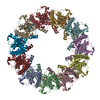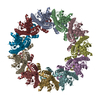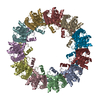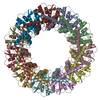+ Open data
Open data
- Basic information
Basic information
| Entry | Database: PDB / ID: 6lmu | ||||||||||||||||||||||||||||||||||||||||||||||||||||||
|---|---|---|---|---|---|---|---|---|---|---|---|---|---|---|---|---|---|---|---|---|---|---|---|---|---|---|---|---|---|---|---|---|---|---|---|---|---|---|---|---|---|---|---|---|---|---|---|---|---|---|---|---|---|---|---|
| Title | Cryo-EM structure of the human CALHM2 | ||||||||||||||||||||||||||||||||||||||||||||||||||||||
 Components Components | Calcium homeostasis modulator protein 2 | ||||||||||||||||||||||||||||||||||||||||||||||||||||||
 Keywords Keywords | MEMBRANE PROTEIN / channel | ||||||||||||||||||||||||||||||||||||||||||||||||||||||
| Function / homology |  Function and homology information Function and homology informationregulation of microglial cell activation / ATP export / calcium ion import / monoatomic cation channel activity / regulation of synaptic plasticity / positive regulation of apoptotic process / plasma membrane Similarity search - Function | ||||||||||||||||||||||||||||||||||||||||||||||||||||||
| Biological species |  Homo sapiens (human) Homo sapiens (human) | ||||||||||||||||||||||||||||||||||||||||||||||||||||||
| Method | ELECTRON MICROSCOPY / single particle reconstruction / cryo EM / Resolution: 3.4 Å | ||||||||||||||||||||||||||||||||||||||||||||||||||||||
 Authors Authors | Demura, K. / Kusakizako, T. / Shihoya, W. / Hiraizumi, M. / Shimada, H. / Yamashita, K. / Nishizawa, T. / Nureki, O. | ||||||||||||||||||||||||||||||||||||||||||||||||||||||
 Citation Citation |  Journal: Sci Adv / Year: 2020 Journal: Sci Adv / Year: 2020Title: Cryo-EM structures of calcium homeostasis modulator channels in diverse oligomeric assemblies. Authors: Kanae Demura / Tsukasa Kusakizako / Wataru Shihoya / Masahiro Hiraizumi / Kengo Nomura / Hiroto Shimada / Keitaro Yamashita / Tomohiro Nishizawa / Akiyuki Taruno / Osamu Nureki /  Abstract: Calcium homeostasis modulator (CALHM) family proteins are Ca-regulated adenosine triphosphate (ATP)-release channels involved in neural functions including neurotransmission in gustation. Here, we ...Calcium homeostasis modulator (CALHM) family proteins are Ca-regulated adenosine triphosphate (ATP)-release channels involved in neural functions including neurotransmission in gustation. Here, we present the cryo-electron microscopy (EM) structures of killifish CALHM1, human CALHM2, and CLHM-1 at resolutions of 2.66, 3.4, and 3.6 Å, respectively. The CALHM1 octamer structure reveals that the N-terminal helix forms the constriction site at the channel pore in the open state and modulates the ATP conductance. The CALHM2 undecamer and CLHM-1 nonamer structures show the different oligomeric stoichiometries among CALHM homologs. We further report the cryo-EM structures of the chimeric construct, revealing that the intersubunit interactions at the transmembrane domain (TMD) and the TMD-intracellular domain linker define the oligomeric stoichiometry. These findings advance our understanding of the ATP conduction and oligomerization mechanisms of CALHM channels. | ||||||||||||||||||||||||||||||||||||||||||||||||||||||
| History |
|
- Structure visualization
Structure visualization
| Movie |
 Movie viewer Movie viewer |
|---|---|
| Structure viewer | Molecule:  Molmil Molmil Jmol/JSmol Jmol/JSmol |
- Downloads & links
Downloads & links
- Download
Download
| PDBx/mmCIF format |  6lmu.cif.gz 6lmu.cif.gz | 492.5 KB | Display |  PDBx/mmCIF format PDBx/mmCIF format |
|---|---|---|---|---|
| PDB format |  pdb6lmu.ent.gz pdb6lmu.ent.gz | 405.8 KB | Display |  PDB format PDB format |
| PDBx/mmJSON format |  6lmu.json.gz 6lmu.json.gz | Tree view |  PDBx/mmJSON format PDBx/mmJSON format | |
| Others |  Other downloads Other downloads |
-Validation report
| Summary document |  6lmu_validation.pdf.gz 6lmu_validation.pdf.gz | 1.1 MB | Display |  wwPDB validaton report wwPDB validaton report |
|---|---|---|---|---|
| Full document |  6lmu_full_validation.pdf.gz 6lmu_full_validation.pdf.gz | 1.1 MB | Display | |
| Data in XML |  6lmu_validation.xml.gz 6lmu_validation.xml.gz | 79.2 KB | Display | |
| Data in CIF |  6lmu_validation.cif.gz 6lmu_validation.cif.gz | 109.3 KB | Display | |
| Arichive directory |  https://data.pdbj.org/pub/pdb/validation_reports/lm/6lmu https://data.pdbj.org/pub/pdb/validation_reports/lm/6lmu ftp://data.pdbj.org/pub/pdb/validation_reports/lm/6lmu ftp://data.pdbj.org/pub/pdb/validation_reports/lm/6lmu | HTTPS FTP |
-Related structure data
| Related structure data |  0920MC  0919C  0921C  0922C  0923C  6lmtC  6lmvC  6lmwC  6lmxC M: map data used to model this data C: citing same article ( |
|---|---|
| Similar structure data | |
| EM raw data |  EMPIAR-10444 (Title: Cryo-EM structures of calcium homeostasis modulator (CALHM) channels EMPIAR-10444 (Title: Cryo-EM structures of calcium homeostasis modulator (CALHM) channelsData size: 6.8 TB Data #1: Unaligned movies for OlCALHM1 [micrographs - multiframe] Data #2: Unaligned movies for HsCALHM2 [micrographs - multiframe] Data #3: Unaligned movies for CeCLHM-1 [micrographs - multiframe] Data #4: Unaligned movies for OlCALHM1-HsCALHM2 chimera [micrographs - multiframe]) |
- Links
Links
- Assembly
Assembly
| Deposited unit | 
|
|---|---|
| 1 |
|
- Components
Components
| #1: Protein | Mass: 37006.367 Da / Num. of mol.: 11 Source method: isolated from a genetically manipulated source Source: (gene. exp.)  Homo sapiens (human) / Gene: CALHM2, FAM26B / Production host: Homo sapiens (human) / Gene: CALHM2, FAM26B / Production host:  Homo sapiens (human) / References: UniProt: Q9HA72 Homo sapiens (human) / References: UniProt: Q9HA72Has protein modification | Y | |
|---|
-Experimental details
-Experiment
| Experiment | Method: ELECTRON MICROSCOPY |
|---|---|
| EM experiment | Aggregation state: PARTICLE / 3D reconstruction method: single particle reconstruction |
- Sample preparation
Sample preparation
| Component | Name: CALHM2 / Type: COMPLEX / Entity ID: all / Source: RECOMBINANT |
|---|---|
| Molecular weight | Experimental value: NO |
| Source (natural) | Organism:  Homo sapiens (human) Homo sapiens (human) |
| Source (recombinant) | Organism:  Homo sapiens (human) Homo sapiens (human) |
| Buffer solution | pH: 8 |
| Specimen | Embedding applied: NO / Shadowing applied: NO / Staining applied: NO / Vitrification applied: YES |
| Vitrification | Cryogen name: ETHANE |
- Electron microscopy imaging
Electron microscopy imaging
| Experimental equipment |  Model: Titan Krios / Image courtesy: FEI Company |
|---|---|
| Microscopy | Model: FEI TITAN KRIOS |
| Electron gun | Electron source:  FIELD EMISSION GUN / Accelerating voltage: 300 kV / Illumination mode: OTHER FIELD EMISSION GUN / Accelerating voltage: 300 kV / Illumination mode: OTHER |
| Electron lens | Mode: BRIGHT FIELD |
| Image recording | Electron dose: 60 e/Å2 / Film or detector model: FEI FALCON III (4k x 4k) |
- Processing
Processing
| Software | Name: PHENIX / Version: 1.14_3260: / Classification: refinement |
|---|---|
| EM software | Name: PHENIX / Category: model refinement |
| CTF correction | Type: PHASE FLIPPING AND AMPLITUDE CORRECTION |
| 3D reconstruction | Resolution: 3.4 Å / Resolution method: FSC 0.143 CUT-OFF / Num. of particles: 365116 / Symmetry type: POINT |
 Movie
Movie Controller
Controller










 PDBj
PDBj